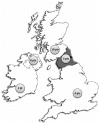Two recurrent mutations are associated with GNE myopathy in the North of Britain
- PMID: 24695763
- PMCID: PMC6625961
- DOI: 10.1136/jnnp-2013-306314
Two recurrent mutations are associated with GNE myopathy in the North of Britain
Abstract
Objective: GNE myopathy is a rare recessive myopathy associated with inclusion bodies on muscle biopsy. The clinical phenotype is associated with distal muscle weakness with quadriceps sparing. Most of the current information on GNE myopathy has been obtained through studies of Jewish and Japanese patient cohorts carrying founder mutations in the GNE gene. However, little is known about GNE myopathy in Europe where the prevalence is thought to be very low.
Methods: Patients were referred through the National Specialist Commissioning Team service for limb-girdle muscular dystrophies at Newcastle (UK). All patients harbouring mutations in the GNE gene were recruited for our study. Detailed clinical and genetic data as well as muscle MRIs and muscle biopsies were reviewed.
Results: We identified 26 patients harbouring mutations in the GNE gene. Two previously reported mutations (c.1985C>T, p.Ala662Val and c.1225G>T, p.Asp409Tyr) were prevalent in the Scottish, Northern Irish and Northern English populations; with 90% of these patients carrying at least one of the two mutations. Clinically, we confirmed the homogenous pattern of selective quadriceps sparing but noted additional features like asymmetry of weakness at disease onset.
Conclusions: GNE myopathy is an important diagnosis to consider in patients presenting with distal leg muscle weakness. We report, for the first time, two common mutations in the north of Britain and highlight the broader spectrum of clinical phenotypes. We also propose that the prevalence of GNE myopathy may be underestimated due to the frequent absence of rimmed vacuoles in the muscle biopsy.
Keywords: GENETICS; INCL BODY MYOSITIS; MUSCLE DISEASE; MYOPATHY; NEUROMUSCULAR.
Published by the BMJ Publishing Group Limited. For permission to use (where not already granted under a licence) please go to http://group.bmj.com/group/rights-licensing/permissions.
Figures



Similar articles
-
Identification of a GNE homozygous mutation in a Han-Chinese family with GNE myopathy.J Cell Mol Med. 2018 Nov;22(11):5533-5538. doi: 10.1111/jcmm.13827. Epub 2018 Aug 29. J Cell Mol Med. 2018. PMID: 30160005 Free PMC article.
-
Long term clinical follow-up and natural history in a cohort of Italian patients with GNE myopathy: the experience of a single centre.Neurol Sci. 2025 Sep;46(9):4645-4652. doi: 10.1007/s10072-025-08265-w. Epub 2025 May 31. Neurol Sci. 2025. PMID: 40447857
-
Mutational spectrum and clinical features in 35 unrelated mainland Chinese patients with GNE myopathy.J Neurol Sci. 2015 Jul 15;354(1-2):21-6. doi: 10.1016/j.jns.2015.04.028. Epub 2015 Apr 27. J Neurol Sci. 2015. PMID: 25986339
-
[GNE myopathy].Med Sci (Paris). 2015 Nov;31 Spec No 3:20-7. doi: 10.1051/medsci/201531s306. Epub 2015 Nov 6. Med Sci (Paris). 2015. PMID: 26546927 Review. French.
-
GNE myopathy: current update and future therapy.J Neurol Neurosurg Psychiatry. 2015 Apr;86(4):385-92. doi: 10.1136/jnnp-2013-307051. Epub 2014 Jul 7. J Neurol Neurosurg Psychiatry. 2015. PMID: 25002140 Free PMC article. Review.
Cited by
-
GNE Myopathy With Novel Mutations and Pronounced Paraspinal Muscle Atrophy.Front Neurol. 2018 Nov 8;9:942. doi: 10.3389/fneur.2018.00942. eCollection 2018. Front Neurol. 2018. PMID: 30467490 Free PMC article.
-
The frequent variant A57F in the GNE gene in patients from Russia has Finno-Ugric Mari origin.Front Genet. 2024 Dec 11;15:1511304. doi: 10.3389/fgene.2024.1511304. eCollection 2024. Front Genet. 2024. PMID: 39722797 Free PMC article.
-
Genetic and Clinical Spectrum of GNE Myopathy in Russia.Genes (Basel). 2022 Oct 31;13(11):1991. doi: 10.3390/genes13111991. Genes (Basel). 2022. PMID: 36360228 Free PMC article.
-
GNE myopathy: from clinics and genetics to pathology and research strategies.Orphanet J Rare Dis. 2018 May 2;13(1):70. doi: 10.1186/s13023-018-0802-x. Orphanet J Rare Dis. 2018. PMID: 29720219 Free PMC article. Review.
-
GNE myopathy: History, etiology, and treatment trials.Front Neurol. 2022 Oct 18;13:1002310. doi: 10.3389/fneur.2022.1002310. eCollection 2022. Front Neurol. 2022. PMID: 36330422 Free PMC article. Review.
References
-
- Pogue R, Anderson LV, Pyle A, et al. Strategy for mutation analysis in the autosomal recessive limb-girdle muscular dystrophies. Neuromuscul Disord. 2001;11:80–87. - PubMed
-
- Darin N, Kyllerman M, Wahlstrom J, Martinsson T, Oldfors A. Autosomal dominant myopathy with congenital joint contractures, ophthalmoplegia, and rimmed vacuoles. Annals of neurology. 1998;44:242–248. - PubMed
-
- Horowitz SH, Schmalbruch H. Autosomal dominant distal myopathy with desmin storage: a clinicopathologic and electrophysiologic study of a large kinship. Muscle Nerve. 1994;17:151–160. - PubMed
Publication types
MeSH terms
Substances
Grants and funding
LinkOut - more resources
Full Text Sources
Other Literature Sources
